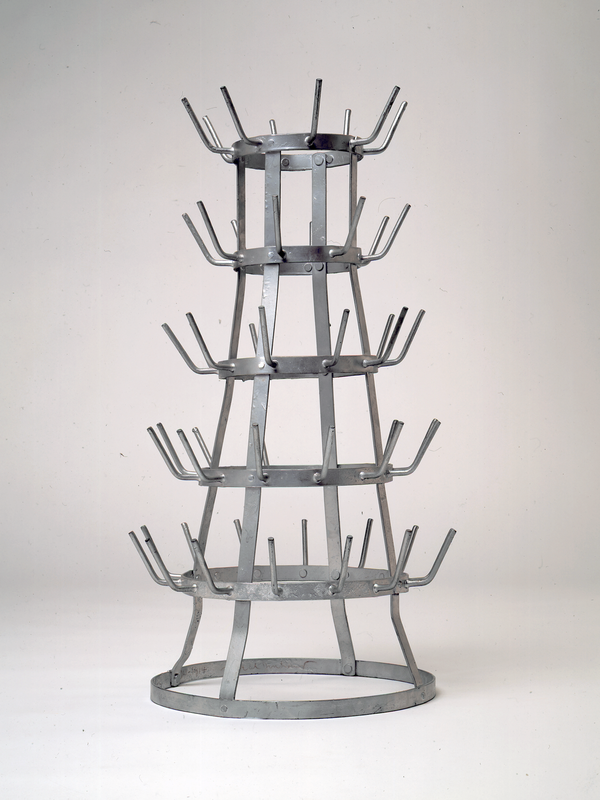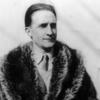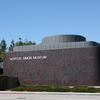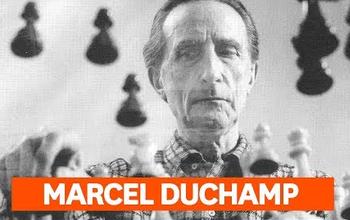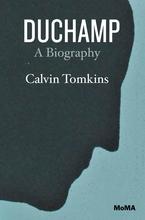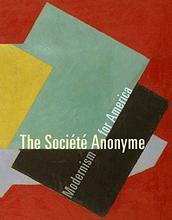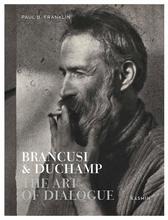More about Bottle Dryer (Bottlerack)
- All
- Info
- Video
- Shop

Contributor
Duchamp's Bottle Dryer (Bottlerack) is a gift made to the Norton Simon Museum in the artist's memory from the gallerist Irving Blum, who appeared five years earlier at a Duchamp retrospective with Dennis Hopper, posing for a photograph whilst pinching Andy Warhol's cheeks with his cigarette-holding hand.
The Bottle Dryer (Bottlerack) is often touted by critics as Duchamp's first bona fide "readymade," because he did not physically alter the object in any way, aside from writing something on it, before he presented it to stupefied viewers as a work of art. At the dawn of World War I, Duchamp was living in New York when he had the sudden insight that a bottlerack, upon which he based this replica, could be a work of art. He asked his sister, the artist Suzanne Duchamp, to go to his old studio at the Rue Saint-Hippolyte and sign it with his name and an inscription, which he later forgot, or claimed to have forgotten.
But Suzanne had already thrown it out! As Duchamp recalls, "My sister and sister-in-law took everything out, threw it in the garbage, and said no more about it." However, as Andrew Russeth astutely writes, "(Marcel had earlier asked her to clean out his studio, so this was very much his fault.) Depending on how you look at it, then, the first readymade never actually existed, was only partially completed, or was discarded shortly after its creation (after existing pretty much only in Marcel’s head)." The whole scenario could not have been better orchestrated by Duchamp if he had consciously planned to lose the original bottlerack. Not only is this the type of conceptual puzzle game he loved to play, but the story of it being his sister's fault resonated with all the critics and artists who felt ambivalent about their domestic relationships to women, even if it was completely, well, readymade. If you read between the lines, it seems like Duchamp didn't fully intend to keep the original, because, genius and master showman that he was, he knew that we always want what we can't have. If you told me the Duchamp siblings orchestrated it all, I wouldn't argue with you.
Of the seven "original copies" of Duchamp bottleracks, this Norton Simon version is the tallest, measuring 73.8cm, over ten centimeters taller than most of them. The only other one that approaches this height is the one from Milan, the production of which Duchamp supervised, based on a Man Ray photograph of the third bottlerack, which the two artists had purchased together for an exhibition at the Galerie Charles Ratton in Paris. This last bottlerack is now lost, and if you find it, make sure to hire Saul Goodman, because it's worth millions.
Although at least one critic disagrees, Duchamp claims to have purchased the original bottlerack from Bazar de l’Hôtel de Ville, a store in Paris. There is something inescapably French about the device, used for drying wine bottles: it's hard to imagine any department store in the U.S. selling something like this for mass consumption, but the Bazar de l’Hôtel de Ville still has them, though now made of plastic. Many critics speculate that the bottleracks are a sexual innuendo referring to Duchamp's bachelorhood, but, as Duchamp himself insisted, he chose the readymade based on complete absence of feeling, total indifference, and "anesthesia." Maybe the bottleracks were just a place for Rrose Sélavy, Duchamp's female alter ego, to hang her stilettos and wigs.
Robert Rauschenberg purchased an original copy of this piece for $3, the price of a Barbie doll at the time, at a Duchamp show in New York titled "Art and the Found Object." Fifty-seven years later, when the Art Institute of Chicago purchased it from him for a secret price, an auctioneer estimated that they would have paid at least $12 million. "This is the most important piece of art I have handled in my life at the gallery," whispered Thaddaeus Ropac, the Austrian art dealer who carefully facilitated the transfer of the now exorbitantly priced bottlerack on behalf of the Robert Rauschenberg Foundation.
Sources
- "Bottle Dryer (Bottlerack)." Norton Simon Museum, 2017, https://www.nortonsimon.org/art/detail/P.1968.28.
- "Bottle Rack or Bottle Dryer." Binghamton University, https://web.archive.org/web/20080127015923/http://arthist.binghamton.ed….
- Cohen, Alina. "Why Marcel Duchamp Played Chess with a Naked Eve Babitz." Artsy, May 16, 2019, https://www.artsy.net/article/artsy-editorial-marcel-duchamp-played-che….
- Johnson, Steve. "Art Institute wins global competition for modern masterpiece — a multimillion dollar bottle rack." Chicago Tribune, Feb. 13, 2018, https://www.chicagotribune.com/entertainment/ct-ent-art-institute-marce…
- Russeth, Andrew. "Robert Rauschenberg’s Rare Duchamp Readymade Goes to Art Institute of Chicago." ARTnews, Feb. 13, 2018, https://www.artnews.com/art-news/news/robert-rauschenbergs-rare-duchamp….
- Tomkins, Calvin. "Kitchen Sink." The New Yorker, Jan. 25, 2016, https://www.newyorker.com/magazine/2016/02/01/kitchen-sink.
- Wasser, Julian. "Andy Warhol, Irving Blum, Billy Al Bengston and Dennis Hopper, at the Opening Reception, Duchamp Retrospective, Pasadena art Museum." Robert Berman Gallery, https://www.artsy.net/artwork/julian-wasser-andy-warhol-irving-blum-bil…

